It was time to say selamat tinggal (goodbye) to Indonesia. I will always remember and miss the foods and the kind openness of people eager to talk. I will remember the smoke everywhere: burning trash, sizzling sate (satay), tobacco, exhaust fumes and incense.
We learned so much, though we saw only a small part of the expansive country.
Quick stats
- 3 months (with a 1 week visa run to Kuala Lumpur)
- 8 accommodations: 5 guest houses, 3 homestays
- 7 places: Canggu, Ubud, and briefly in Munduk in Bali; Borobudur and Yogya in Java; Bukittingi and Maninjau in Sumatra
- 4 airports: Denpasar, Yogyakarta, Jakarta, and Padang
 Sunset over Danau Maninjau
Sunset over Danau Maninjau
Danau Maninjau
We took a speedy shared taxi from Bukittingi to a quiet retreat to a cabin on Danau Maninjau (Lake Maninjau). It is a crater lake with the near circular rim wrapping round all sides. We had to descend the rim (44 switchbacks!) to get to our cabin in the small village of Maninjau. We found that the crater rim seemed to fend off the storm clouds, and provided an amazing backdrop for sunsets. Our cabin was in the busiest part of the lake, which is not saying much because the whole lake was rather quiet. We imagined that this would probably be the most isolated (least touristy) stay in our big trip.
Although there were some issues with the cabin, we enjoyed the quiet and isolation. The lake is not really for swimming, but Asa enjoyed playing in the water and throwing stones. Fishing nets and fish cages for farming were seen everywhere. At some point we heard the lake had become over-polluted (probably from too much fish farming and motorboats), but as far as we could tell it was starting to recover.
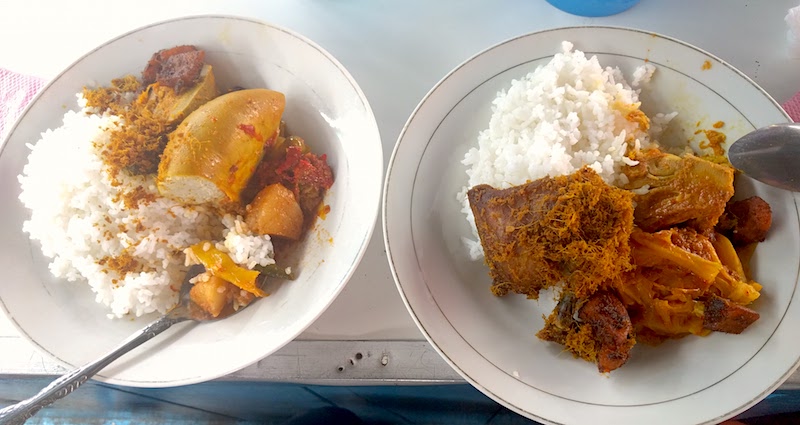 Typical lunch plates in Sumatra
Typical lunch plates in Sumatra
Food options were limited but mostly quite cheap. Although there were standard Indonesian dishes to be found (nasi goreng and mee goreng), West Sumatra is famous throughout Indonesia as the home of rendang, a spicy-sweet meat dish (usually beef, sometimes chicken) which is made by basically adding a bunch of spices and seasoning to a simmering pot of meat and you simmer over several hours until there is almost no liquid left. The meat becomes quite tender and almost preserved so that (evidently) it can be eaten over several days. I really grew to enjoy the distinct flavor, that I can’t quite recall having outside Indonesia, though it was sometimes too spicy for Kanako and Asa.
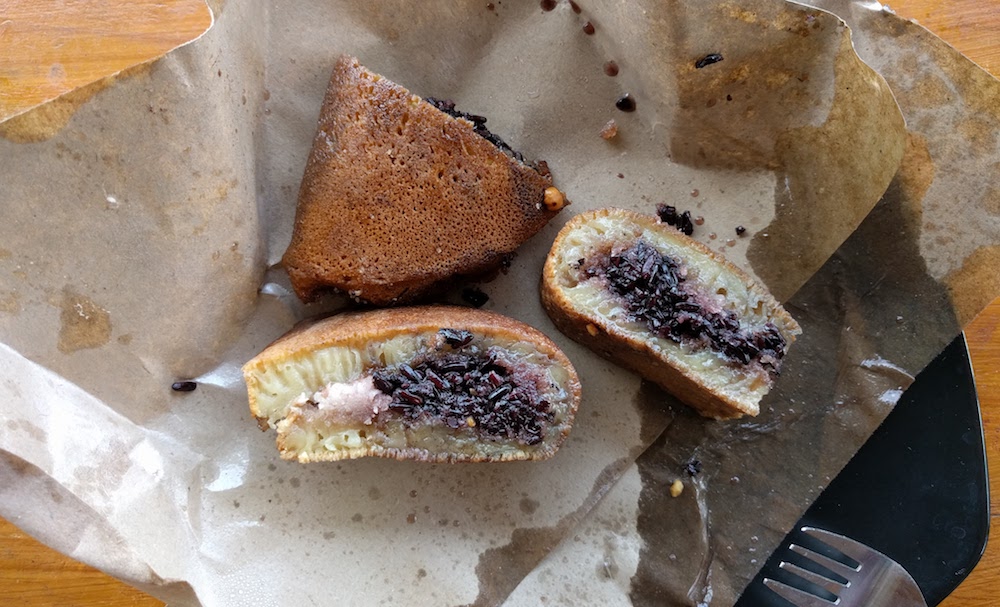 Martabak, mmm
Martabak, mmm
The other food highlight was martabak, which we bought freshly made at the local markets. The word comes from the Arabic word for “fold” or “folded”, and has many variations throughout Indonesia and the Muslim world. The version in Sumatra seems to be a large fluffy pancake covered with sweet stuff (peanuts, coconut rice, chocolate sprinkles, etc.), then folded like a taco and cut into pieces. Mmmmm.
On our last day in Maninjau we were in an adventurous mood and took a motorbike to try for a short hike partway up the crater rim to a waterfall. We saw a giant millipede, and at the time I thought it might be a centipede, but I’m pretty sure it was a giant flat-backed millipede — about 20 cm long, and I was sad that I couldn’t get a good photo of it. The hiking path was not so clear, too difficult for Asa to get all the way to waterfall, so I trekked up the last 200m to the base of the waterfall, with an eerie feeling that the jungle was bearing down on me. Right when I made it back to Asa and Kanako, Asa fell forward hands-first into a small patch of some poisonous plant, which made for an unpleasant hike down. Luckily, an hour later he was fine.
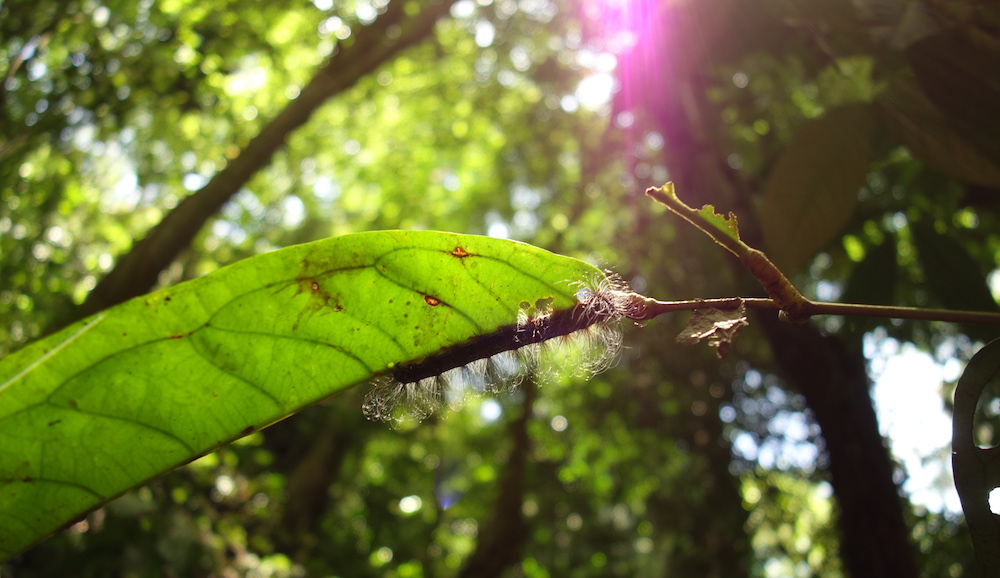 An imposing caterpillar from our waterfall hike
An imposing caterpillar from our waterfall hike
Leaving Yogyakarta, we stop for a short layover in Jakarta, and arrive at the coastal Padang Airport, in West Sumatra and take a 2-hr taxi ride to the highlands. We stay in Bukittingi for 5 days in a simple hostel-like guesthouse and 10 days at Airbnb cabin on Lake Maninjau.
To give a sense of scale in Indonesia… Indonesia is the 4th most populous country in the world, and has 17,000 islands. Bali is pretty small — about the size of Delaware, or twice as big as Tokyo. Java is a big island, roughly the size of England. Java is also the most populous island) in the world and contains half of Indonesia’s population. Sumatra is 3x bigger — longer and bigger than California, with much less people.
Bukittingi
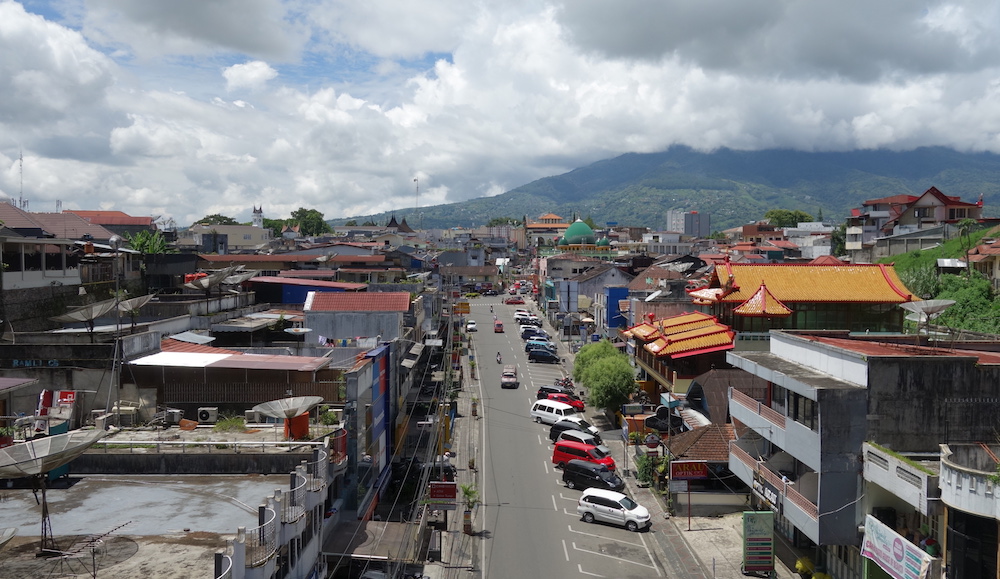 View of the main road in Bukittingi
View of the main road in Bukittingi
Bukittinggi is a medium-sized town in the highlands roughly in the middle of three large mountains. We came during the low tourist season so people seemed a little surprised to see foreigners. In the 80’s and 90’s tourism was at a high in West Sumatra. In the late 90’s economic crisis and political upheaval hit Sumatra very hard. Some Islamic terrorist attacks in the country also discouraged tourists from this almost completely Muslim region.
Bukittingi is effectively the center of the Minangkabau cultural region. The Minangkabau is a cultural subgroup historically spanning much of West Sumatra. It famous for being a matriarchal society, where women hold land rights and control much of the family affairs. As a result the males in the family have historically left the region to stake claims outside West Sumatra (mainly Java and Malaysia). This may explain why the language of Minangkabau is so similar to Bahasa Indonesia (official language of Indonesia) and Bahasa Malaysia (official language of Malaysia).
Minangkabau are also known to emphasize education. One evening we were gingerly approached by a group of three university students to ask if they could ask a few questions for their English class and a short conversation. We were later approached by two more groups, a little embarrassed but very friendly and we happily posed for their photos – and we imagined we would appear in their class’s presentations a few times. So Bukittingi is also known as a center of education, especially Muslim education. We saw some boarding schools and small universities around. According to some stats, West Sumatra is about 97% Muslim, and the matriarchal aspects of Minangkabau have sometimes been in conflict with the traditional Muslim parts, but even now they seem to coexist in households.

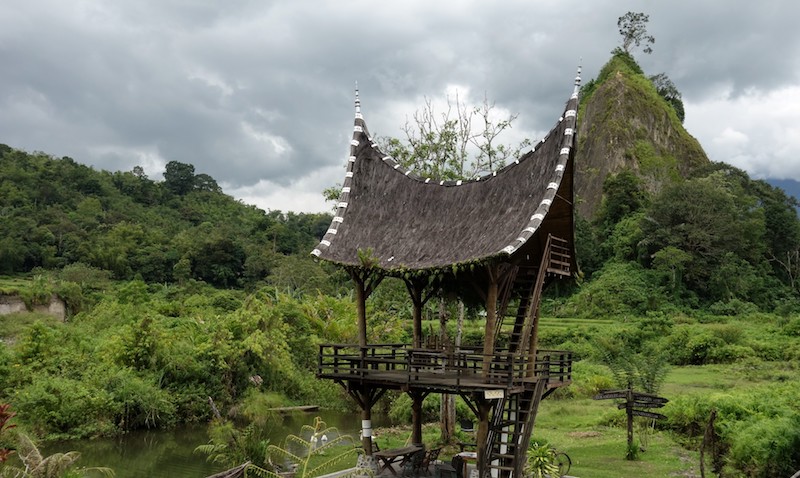 Water buffalo and roof spires on a treehouse
Water buffalo and roof spires on a treehouse
The town itself was pleasant but didn’t have many attractions. We looked at the dilapidated zoo and adjoining Fort de Kock, a Dutch relic. We explored the large local market — which had a huge, pungent area for meat (mostly beef and chicken) and another huge, more pungent area for fish. Because of the smells Asa no longer likes going to the local markets. Being a mountain town, the prevalence of fish was surprising to us. Much of the fish comes from Lake Maninjau, but also many homes maintain large reservoirs of water near or sometimes under their houses to raise fish.
In our last full day in Bukittingi we walked down an extensive network of Japanese caves constructed during WWII. And when we came out the other side a guide convinced us to on a guided hike down through the nearby canyon and into the small neighboring rice fields and village. Many houses are built in the traditional Minangkabau style with pointy roof spires that are modeled after the horns of the water buffalo, to embody their strength, as the water buffalo have been very important to the agriculture in the region. These pointy roof spires can be found everywhere: on modest homes, local government buildings, mailboxes and signposts. But there are also many houses here and there that are built in the Dutch colonial style, remnants of the colonial past.
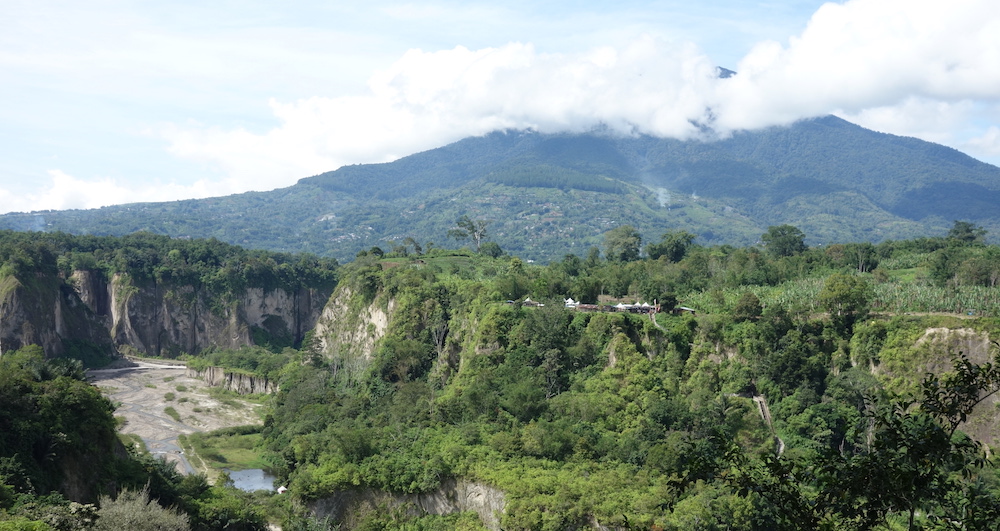 Canyon and Mt. Merapi hidden behind clouds
Canyon and Mt. Merapi hidden behind clouds
After 2 intense days of temples we settle in Yogyakarta, known as a city of education for all things traditionally Javanese (music, theater, textiles, etc.). We didn’t venture to any of the many universities, but we did see many young people in central Yogya where we were staying.
The city is also the capital of the Special Region of Yogyakarta — special, because it has a sultan. The sultanate existed apparently since prehistory, and survived the waves of European colonization and Indonesian independence. When independence was declared, the Sultan expressed his allegiance and in return was granted a special status. We visited the Sultan’s palace, a large estate suffering in disrepair, but preserving some interesting elements of history.
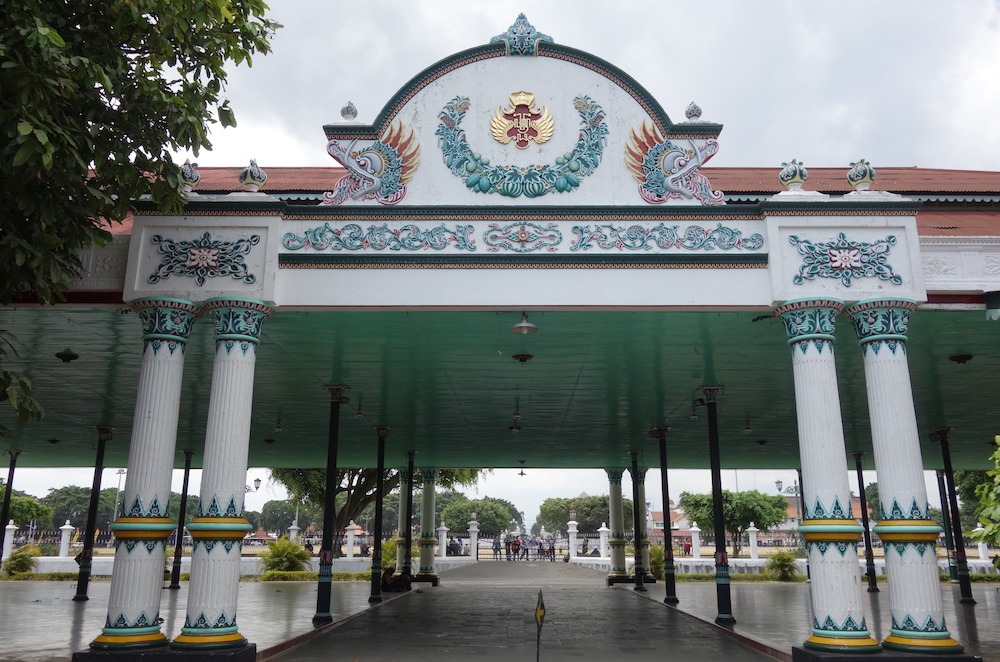 Sultan’s Palace in Yogyakarta
Sultan’s Palace in Yogyakarta
Yogya is a big city, with few visible Western tourists. Although more walkable than much of Bali, the city center is full of exhaust fumes hovering in the hot air. We walked the main thoroughfare (Jalan Malioboro) down to the local market area, which is absolutely packed with hundreds or thousands of vendors mostly selling batik clothing or other clothing. After some hours it’s dizzying to take in all the patterns, materials, of different sizes and purposes, etc. The true central market is a maze of stalls stocked from floor to ceiling in endless batiks.
Javanese Theater
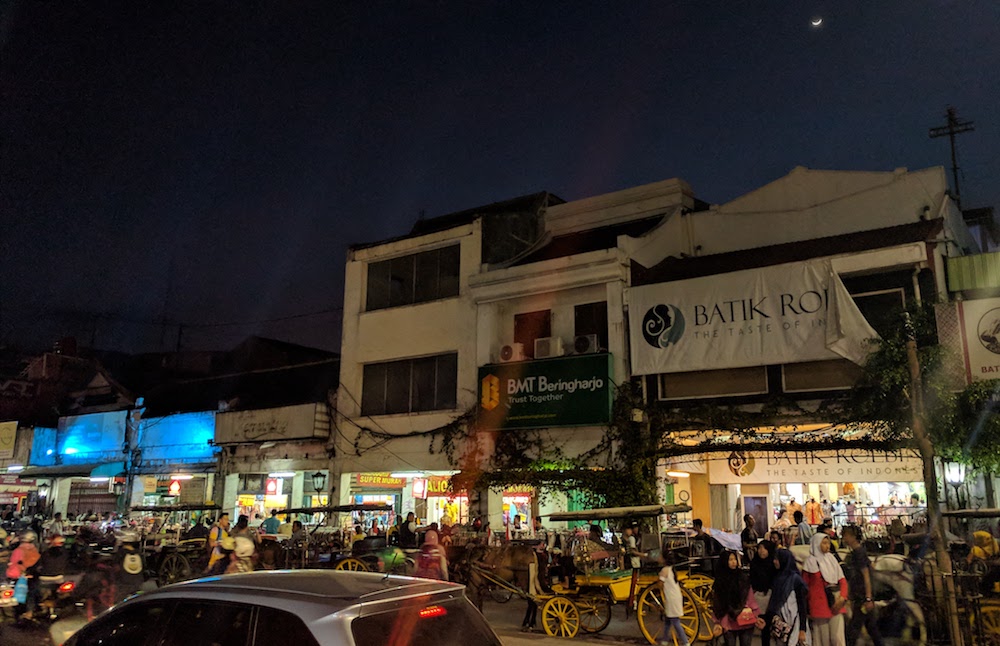 Jalan Malioboro in Yogyakarta
Jalan Malioboro in Yogyakarta
We spent two evenings enjoying traditional Javanese theater. The first, Ramayana Ballet, overpriced and of mediocre quality was nevertheless intriguing. The same Ramayana story presented in the reliefs of Prambanan. The second, traditional puppet theater, also telling the story of Ramayana. The puppet theater was underpriced and quite enjoyable. The performance is led by a single puppeteer who sets the pace for the ensemble of musicians to follow. The puppeteer also has some musical methods to control the tension of the scene (like tapping a wooden box, or using one of his feet to chime a cymbal.
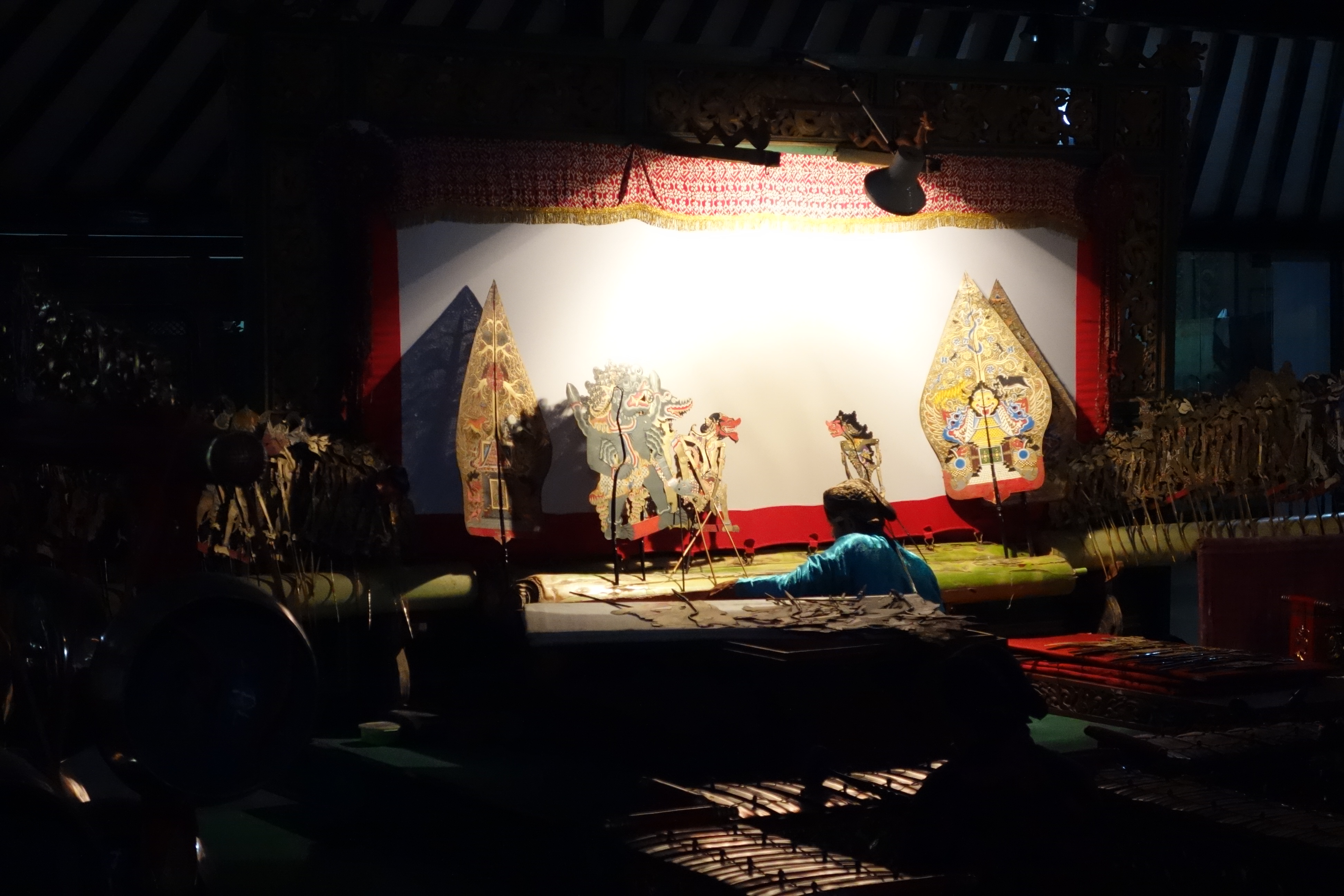 Puppet theater in Yogyakarta
Puppet theater in Yogyakarta
The puppet performance had a curious mix of the serious focus of a sacred ritual and the casual atmosphere of performing with friends. Some of the musicians waved at Asa, and one invited a young woman to sit and play the instrument with him. This kind of mixed atmosphere was one I had seen in many performances through out Indonesia. Overall, it made things more enjoyable.